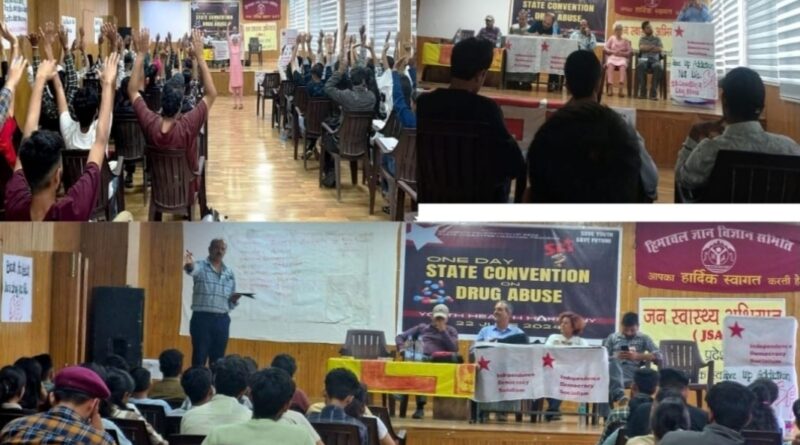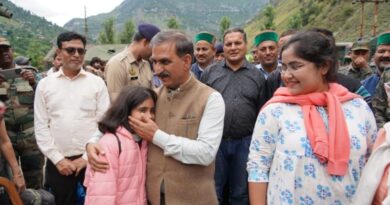Himachal’s Battle Against Drug Menace: Community Movements Step In Where Systems Fail
( By Ayushi Pundir, A student of Himachal Pradesh and an active member of People Science Moment )
Drug abuse is not just a personal struggle—it is a growing social crisis in India. It refers to the compulsive use of addictive substances like cocaine, heroin, MDMA, and synthetic drugs, despite their harmful physical and psychological effects. Young people are particularly vulnerable, often pushed into substance use by peer pressure, family conflicts, stress, anxiety, depression, or unrealistic expectations.
The Alarming Drug Crisis in Himachal Pradesh
Himachal Pradesh today faces a serious challenge with rising drug addiction. Sharing borders with Punjab, Jammu & Kashmir, and Chandigarh, the state has become vulnerable to heroin and synthetic drug inflows. Worryingly, government surveys reveal that around 27% of the youth in Himachal are involved in drug abuse, and among them, 35% are addicted to synthetic drugs like ‘chitta’.
This ongoing drug crisis in Himachal Pradesh mirrors the trend in neighboring states where drug use has shifted from natural substances such as charas to more dangerous synthetic drugs. The impact is devastating—cases of overdose, deteriorating health, and even deaths are increasingly reported among young people.
Why Combating Drug Abuse is Difficult
The drug menace in Himachal thrives due to a strong profit-driven supply chain and widespread trafficking, fueled by the state’s geographical access routes. Weak treatment systems, limited de-addiction centers in Himachal, and lack of awareness make rehabilitation difficult.
At the same time, rave parties in tourist hotspots like Kullu, Manali, and Kasol and the illegal cultivation of cannabis and opium further aggravate the problem. Unfortunately, political hesitation in taking bold action has only allowed the issue to deepen.
HGVS: A Grassroots Ray of Hope
Amid this growing menace, the Himachal Gyan Vigyan Samiti (HGVS) has emerged as a beacon of hope. As a leading voluntary organization, HGVS treats drug addiction in Himachal Pradesh not merely as a health issue but as a social challenge requiring medical, psychological, and community-based solutions.
Recognizing the stigma that often prevents families from seeking help, HGVS promotes an approach centered on prevention, treatment, and youth rehabilitation in Himachal rather than punishment.
Campaigns and Initiatives Against Drug Abuse
HGVS has launched several innovative initiatives to tackle the crisis:
- CoWin DoST (Covid Winning Disseminator of Scientific Temperament): Addressed youth mental health through online expert sessions.
- Yuva Bachao Abhiyan (Save the Youth Campaign): Focused on research, awareness, and community mobilization to cut demand and disrupt drug supply.
- Himachal Forum Against Drug Abuse (HFADA): A coalition of 43 organizations that stands against criminalization and social exclusion of addicts, advocating for de-addiction and rehabilitation in Himachal Pradesh.
- MAA (Mother Against Addiction): Empowering mothers to identify early signs of addiction and intervene in time.
- Interactive Support Circles: Meetings where recovering addicts and families share experiences, breaking stigma and inspiring others.
- DoST (Peer Mentorship Model): Training young mentors to guide peers away from drugs through positive peer influence.
- Digital Awareness Campaigns: Including the “WHITE Truth” web series, launched on International Youth Day, highlighting the struggles and stigma faced by addicts and their families.
A Call for Collective Action
Despite multiple efforts, the drug abuse problem in Himachal Pradesh continues to grow. Experts and community leaders agree that the solution lies in collective responsibility—where families, society, government, and organizations work together. Rather than isolating or punishing addicts, the focus must remain on healing, support, and drug rehabilitation in Himachal.
Himachal stands at a critical crossroads. With its youth being the backbone of its future, the fight against drugs is no longer optional—it is urgent, it is necessary, and it must be fought together.



